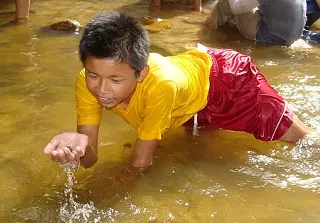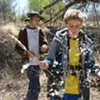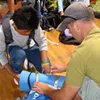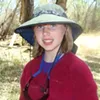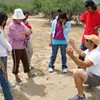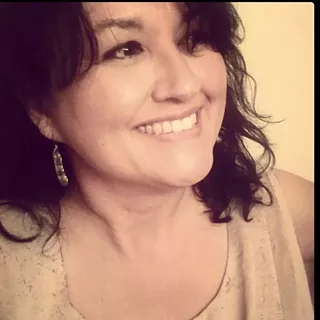It's been five months since Ta Pay left the Thai refugee camp he'd called home since he was born 12 years ago, a place where his parents sought safety from Burmese soldiers during a decades-long struggle that's left thousands dead and thousands of others stuck in camps.
On a recent spring afternoon, Ta Pay joined eight other Burmese refugee kids in the Tucson-area desert. They were getting to know their new surroundings—an environment that's nothing like the lush green jungle they left behind.
Leading the kids on this hike up to the Montrose Pools at Catalina State Park are Eric and Suzanne Dhruv, co-directors of the Center for Children and Nature at Prescott College in Tucson. The kids are participating in the Ironwood Tree Experience, a project the Dhruvs started four years ago that takes middle school and high school kids outdoors to learn about Sonoran Desert ecology—and how they are connected to that ecology.
These kids, however, are different from other Ironwood Tree Experience students. Most are still learning English, and all are there because their parents are worried that their children don't go outside anymore.
"The desert seems so foreign," Suzanne explains.
As Eric begins the slight ascent at the beginning of the hike, he announces that the last time they brought a group of kids up, a few weeks before, there was water in all of the lower pools.
"Water," some of the kids say out loud, visibly excited—and a bit surprised—at the possibility of water in a place like this.
At the lower pools, they find only puddles. Eric tells everyone he thinks there could be more water farther up.
"Do you want to keep going?" he asks the group.
"Yes," they answer. (Eric later admits that this is a tool he uses with all of the kids: He asks them if they're happy where they are, or if they want to keep exploring. Most of the time, he says, they want to keep exploring.)
The group continues over terrain that eventually forces everyone to scramble over large boulders and pull themselves up over rock walls. At another pool area, there is a bit more water, but Eric points up, and everyone follows.
The climb continues as the terrain grows more difficult, but each kid bolts ahead, laughing. Or sometimes shrieking.
"A snake, a snake!" Roe Paw shouts.
Roe Paw is 17 years old, and immigrated to the U.S. from a Thai refugee camp two years ago. She speaks English better than the others, and her skills come in handy to Eric and Suzanne as she helps them translate, passing along knowledge about how to put up a tent or the creatures you sometimes meet in the desert.
It's a garter snake, camouflaged on the side of a rock wall near a path everyone is using to climb up.
It seems like Eric Dhruv lives for moments like these—opportunities to describe the creatures the kids see along the hike, from birds to insects and even plants. This is, after all, why he and his wife started the Ironwood Tree Experience, and why he got his master's degree in environmental studies with a focus on place-based education: to connect kids with the place where they live.
"You do want to watch for rattlesnakes," he tells the group. "But this guy is harmless."
After everyone gets a closer look, the group continues upward, over more boulders, in search of this pool of water Eric has promised.
Finally, from over the last ascent, sounds of laughter and splashing reach those lagging behind (like, for instance, an out-of-shape reporter).
Eric's made good on his promise: The pool of water is almost waist-high and is now filled with kids kicking up water or reaching down to splash each other.
Ta Pay is digging in the sand with a huge grin on his face. Then whimsy takes over as he gets up, runs into the middle of the pool, jumps and declares loudly to everyone there: "I am so happy!"
And there it is: that moment.
"Now that makes this all worth it, doesn't it?" Suzanne asks, smiling at Ta Pay as he reaches down to splash everyone nearby.
The learning continues as the Dhruvs point out a group of silver-colored canyon tree frogs sun-bathing on boulders above the water. Then everyone starts to pull the blue aquatic nets out of their backpacks. They're looking for life—large water bugs and dragonfly larvae are plentiful in this pool of water that will surely evaporate in the heat of the summer.
Back at camp, where orange tents dot the land, the kids break for lunch. All Ironwood participants are asked to pack lunches that are healthy and in reusable containers. This group exceeds expectations; they sit down with stackable containers filled with rice, vegetables and curries.
They sit at one picnic table, passing the different containers to each other. Eric and Suzanne sit at another table with Brice Holmes, one of their two college interns, eating peanut-butter-and-jelly sandwiches.
"They always bring this amazing food, and here we are, with our peanut-butter sandwiches," Suzanne says, laughing.
After lunch, the group sits in front of a map Eric drew of the area, to show them where they are and where Thailand is. They pass out pictures of the animals that live at Catalina State Park. Suzanne asks them about the animals in Thailand.
"Monkeys," someone answers. "And snakes. Many snakes."
But the kids are quick to point out that a refugee camp is hardly like camp at all.
"There are guards. You can't leave," Roe Paw explains. "There are no freedoms."
At an apartment near the intersection of Pima Street and Columbus Boulevard, Roe Paw sits with family and friends; the apartment complex is where many of the Burmese kids participating in the Ironwood Tree Experience group live.
The kids sit with their mothers and fathers in a long row on the floor. The group is quiet until asked to describe life in the refugee camps. Then the room erupts, with five different conversations taking place at once—none in English.
One woman's voice rises above the others; everyone is quiet, and she speaks for several minutes. When she's done, a few people nod their heads in agreement, and Roe Paw turns to interpret.
"To understand what it is like to live in a refugee camp, think about chickens behind a fence. That's what we were like. A chicken coop."
Then the same woman, wearing a colorful native skirt, recalls the day she was forced to leave her village in Burma. That day, dozens of Burmese soldiers came in, shooting people and setting homes on fire.
"We ran and hid in the jungle," Roe Paw says, interpreting. "We stayed a night in a cemetery. Then the soldiers found us, and we ran again until we got to Thailand."
Roe Paw adds: "Many people in her village died, and everything was destroyed."
Most of the people in the apartment lived in Thai refugee camps for more than a decade. What they describe is a life that was often hopeless; there were no jobs in the camp and no way to earn money. Some people grew their own vegetables and were able to sell them, but most of the food was provided by international relief agencies.
"When people ask me, 'What country are you from?'" Roe Paw says, sitting next to her mother, "I don't know how to answer this."
Roe Paw explains that most of the people who come to the United States as Burmese refugees do not really consider themselves to be Burmese, but Karin or Chin instead. The two ethnic groups have struggled to gain independence from Burma. They have their own spoken and written languages, which have survived through decades of Burmese persecution and ethnic cleansing.
In Tucson, the challenges these refugees face are typical for any immigrant community, like learning English and finding jobs. With the country in the midst of a failing economy, however, this is not necessarily the best time to start life over in the United States. This is obvious when one man speaks up and says, "Rent."
Paying rent is the biggest struggle right now, he says. Rent in their apartment building just increased, and the families are wondering how they will get by.
Still, there are no regrets.
"We came here for freedom and peace," Roe Paw says, interpreting for her mother. "We have true freedom here. There is no restricted travel."
Erina Delic, executive director of the Tucson International Alliance of Refugee Communities, says about 80 Burmese refugees arrived in Tucson this past year. The agency—which was founded in 1995, when most refugees were arriving from Vietnam, Cambodia, Angola, the former Soviet Union and the former Yugoslavia—was started by refugees who wanted a place to go for additional community resources.
"Since then, we've become a place where refugees can learn how to drive ... or refugees come to learn about computers," she says.
The refugees, of course, have changed over the years, too. Today, most of the people coming to Tucson are from Iraq, Bhutan, Burundi and Burma.
"Right now, the biggest challenge is the economy and finding jobs. That is something that is affecting a lot of refugees now," says Delic, herself a refugee who arrived here from Croatia 11 years ago.
"Other than that, Tucson looks so different for many refugees. Everyone goes through culture shock, regardless. We all ask ourselves, 'Where is Speedway?' 'What is Circle K?' 'What can I buy in Walgreens?' Or you learn, 'Don't go to Wild Oats for cheap stuff.'"
That culture shock can be especially hard on teenagers, who also have to deal with the same trials as native-born teenagers—like making friends and finding a place to belong.
"Some of the Burmese kids were saying how hard it was to make friends," Suzanne Dhruv explains. "They told us the kids at school speak so fast, and complained that the American kids separate themselves from the Burmese kids. They are not as friendly as they hoped."
During the eight-week class with the Burmese refugees, Eric and Suzanne also worked alternate weekends with a similar group of American kids doing the same class. Suzanne says it was an opportunity to compare and contrast the refugees and the American kids—and the similarities were numerous.
"They've told us that they just don't have other friends with an interest in outdoors or (who are) interested in doing community projects, and that's why they're here," Suzanne says about the American group.
During an April excursion to Cienega Creek with the American teens, it was obvious why these kids were spending time with Eric and Suzanne: to revel in the outdoors.
"Whoa!" says Katie Martinez after looking through a microscope that Eric set up near the Cienega Creek trailhead.
Martinez is one of the nine American kids who participated in this Ironwood Tree Experience program. While there isn't as much water here as the Burmese kids enjoyed up at Catalina State Park, there is enough to make this group happy. They kick off their shoes and socks, roll up their pants and look through the water—aquatic nets in hand—for life.
"What is that?" Katie asks about the flat black creature with round white eyes looking back at her through the microscope.
"It's a flatworm," Eric says, smiling at everyone's looks of shock, mixed with a little disgust and curiosity.
Then there is another monster, caught by Phoebe Meixner: a super-sized water bug, a male, with its back covered in eggs laid by the female.
"That is just amazing," Katie says, exaggerating every word in earnest, while Phoebe beams over her discovery.
The day at Cienega Creek illustrates another of Eric and Suzanne's methods: Learning and playing in nature go hand in hand. Eric sets up a learning center near a fallen tree, with the microscope and a row of nature reference books, and then he sends the kids out to look for water creatures and lizards, to spot birds and to identify the trees and plants along the river.
At one end of the creek, Phoebe finds a spot to examine on her own; she gently pulls at the water with an aquatic net, moving her hands back and forth.
"I worry I might kill something," she replies when told that pulling harder may yield better results. "I like to be gentle."
In another area of the creek, Katie, 12, and Max Kuzma, 15, are looking through dirt and hoping to catch a few lizards.
"My family is really into nature. We compost and everything," she says. "I don't meet a lot people like us who really like to be outside."
That was the point of enrolling her daughter and her son, Tommy, in the program, says Jill Martinez.
"I grew up on 80 acres in northeastern Oklahoma," Jill Martinez explains, adding that the program ended up exceeding her expectations. "... I really like the educational aspect of it. They have a knack of being at the kids' level and taking them down to concepts that most people reserve for grown-ups, to dig down deep on how things work."
Katie's friend Max has let the spirit of the day take over; he takes off his shoes and socks and traipses through the creek area. On the walk back, the bottoms of his jeans are soaked and muddy—surely a sign that this was a good day.
"What were those bugs?" he asks Katie. A few nipped him on his legs as he worked to get his wet socks and shoes back on his feet.
"We'll have to ask Eric again. There were tons of them," she replies.
On the drive home, the question never comes up, as more than half of the kids fall sleep as they travel up Highway 83 and Interstate 10 back into Tucson.
One goal of the Ironwood Tree Experience is to help the kids see their connection to the community. Some weekend excursions take place at local festivals, like Solar Rock and the Chalk Art Festival downtown. But GreenLot, part of the conservation arm of the Center for Children and Nature at Prescott College, offers another way for Eric and Suzanne to show teenagers how they can be part of their city.
The GreenLot projects bring teens together to create lush desert spaces on empty lots. The first GreenLot was created in April 2008 on Country Club Road and Broadway Boulevard. Two months ago, the Burmese and American kids helped with the second GreenLot, at the UA 4-H High Ropes Course off Fort Lowell Road near Interstate 10.
"The goal has been to create a real, true-to-life project that teens can not only be part of, but design and build themselves," Suzanne says. "Many years ago, we were seeing a lot of opportunities for teenagers to be part of conservation projects to pick up trash, or come to a natural park and help clear trails. While that is great work, it's not enough to inspire teenagers."
Suzanne says that she and Eric thought this year's GreenLot project would be a good venue to bring the Burmese and American kids together—but it never really happened. The Burmese kids sat together preparing seeds for the lot, while the American kids scattered around doing different projects, from digging water-harvesting areas to painting rocks.
"We started something, and we want to at least follow it through for a little longer," Suzanne says. "We want the Burmese kids to return, and we want them to interact with the American kids. There are some great opportunities for them to share those common feelings of wanting to belong or feelings of having a role in the community through our projects. These are still kids and still teenagers."
While bringing the Burmese kids together with the American kids was a goal, it wasn't the main point, which was to get a group of Burmese kids outside.
"We are learning," Roe Paw says as she puts her arm around her mother back in that apartment near Pima and Columbus. "It was good for us, and I know we want to do it again."
Sitting in the corner of the living room, Ta Pay nods his head in agreement, and everyone in the room laughs.
"It's part of what we want for our children," Roe Paw's mother says. "We came here for peace and freedom, but we want our children to learn. We want our children to get an education and belong ... (to) be part of this country."
For more information on the Ironwood Tree Experience, visit www.ironwoodtreeexperience.org, or call 319-9868. The group is preparing for its next eco-program, Get Experience, for kids age 13 to 15; it starts June 27.

